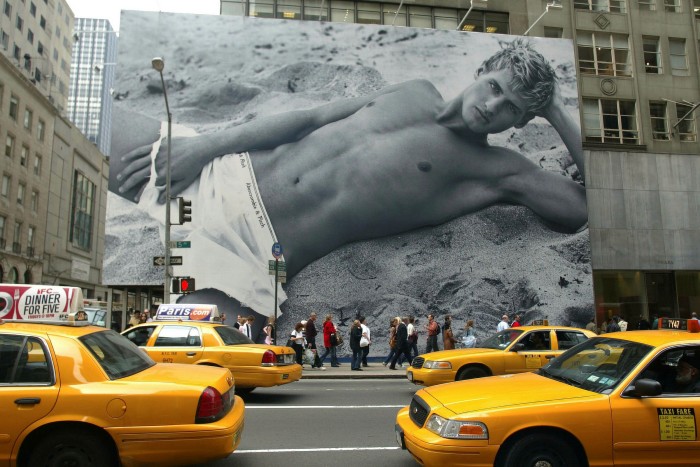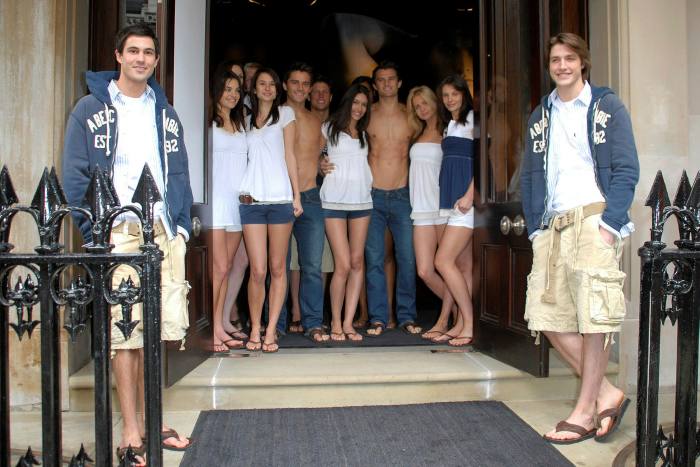
“Friendly reminder: This is a community. We build each other up, not tear each other down,” reads a recent post on the Instagram account of American casualwear brand Abercrombie & Fitch. “Today — and every day — we’re leading with purpose, championing inclusivity and creating a sense of belonging,” reads another message on the brand’s website.
Welcome to #AbercrombieToday, the made-for-Gen-Z reincarnation of one of the most controversial fashion labels of the past three decades.
For anyone who grew up under the influence of American pop culture in the 1990s and early 2000s, it is difficult to reconcile this warm, welcoming rebranding with the Abercrombie of their teenage years. Back then, the label proudly rooted its image and success in the very idea of exclusion. “In every school there are the cool and popular kids, and then there are the not-so-cool kids. Candidly, we go after the cool kids,” former CEO Mike Jeffries famously said in 2006. “We go after the attractive all-American kid with a great attitude and a lot of friends. A lot of people don’t belong [in our clothes], and they can’t belong. Are we exclusionary? Absolutely.”
As Alison Klayman explains in White Hot: The Rise & Fall of Abercrombie & Fitch, her new Netflix documentary chronicling the label’s success and downfall between 1992 and today, it was Jeffries who invented the aspirational “all-American” Abercrombie image that once enthralled teenagers worldwide.

Founded in 1892 as an upscale outdoors brand that sold fishing gear and guns and was favoured by Teddy Roosevelt and Ernest Hemingway, by the end of the 1970s the label had become outdated and gone bankrupt. Its rebirth started in 1992 when Victoria’s Secret owner Les Wexner, who had purchased Abercrombie for £47mn in 1988, hired Jeffries to embark on an ambitious repositioning that would turn it into a hip brand for 18- to 22-year-olds.
Jeffries’ winning formula, as explained in Klayman’s film, was to retain the heritage and elitism associated with the original Abercrombie brand and envelop it in exclusivity, youth and sexuality. The new Abercrombie & Fitch image was exemplified by the erotic black-and-white campaigns shot by Bruce Weber, often depicting athletic and semi-nude youths frolicking in outdoor settings. The photographer also produced most of the imagery included in the brand’s racy catalogue, A&F Quarterly, which often included guides to drinking games and interviews with porn stars. It attracted boycotts and criticism from associations including Mothers Against Drunk Driving, Concerned Christians of America and the National Organization for Women.
Jeffries’ most successful idea, however, was the reinvention of the Abercrombie & Fitch store. In the 1990s and early 2000s, the mall occupied an outsized role in the social life of most American teens. Jeffries turned visiting an Abercrombie & Fitch store into the main highlight of the mall experience. The shops were dimly lit, with club music at full blast, and infused with Fierce, the brand’s signature cologne. Shoppers were often welcomed at the door by bare-chested models, whose images also towered over them in photographs on the walls. Inside, the stores were staffed by sales assistants recruited among fraternities in nearby college campuses, who would also act as unofficial ambassadors of the brand. As journalist Moe Tkacik says in the documentary, “They have absolutely crystallised everything that I hate about high school and put it in a store.”

It was a winning strategy. When Abercrombie & Fitch went public in 1996, its stock, priced originally at $16 a share, closed at $23.12. Between 1994 and 1999, annual sales grew six times to $1.04bn. Jeffries started expanding his empire with the launch of Abercrombie Kids in 1998 and Hollister, a line inspired by the California surfer lifestyle, in 2000. In 2002, he inaugurated the Abercrombie & Fitch headquarters in New Albany, Ohio, a steel-and-glass campus dominated by a cliquey culture and “work hard, play hard” attitude. Jeffries’ control on the brand and his employees was total and unrelenting. “Every piece of Abercrombie was by design, by Mike’s design. The store, the product, the whole thing he would sign off on,” says Cindy Smith-Maglione, A&F’s former vice-president of merchandising, in White Hot.
As it turned out, that culture was also seen as extremely discriminatory. Jeffries’ micromanaging went as far as establishing a set of aesthetic standards for shop-floor employees, including defining appropriate hairstyles (“dreadlocks are unacceptable for men and women”) in a corporate handbook, which described the A&F look as “natural, American, classic”. During the 2000s, Abercrombie was sued by various employees and applicants who accused the retailer of refusing jobs on the basis of their race or religious attire and in one instance moving them from the shop floor to the stockroom because of a disability.
“When it came to the explicit discrimination and the top-down nature of the discrimination, my shock and surprise never went away,” says Klayman, who started working on the project in 2019. “With the story of Abercrombie you get to tease out the systemic top-down nature of how these societal biases were weaponised and enforced on young people within this one corporation.”
Most surprising of all is how long it took for the brand’s popularity to fade. Despite the string of lawsuits and a series of protests against the company’s products (including T-shirts with slogans such as “Wong Brothers Laundry Service — Two Wongs Can Make It White” and thongs for middle-schoolers emblazoned with “Eye Candy” and “Wink Wink”), Abercrombie’s sales didn’t suffer any major reputational setbacks until 2013, when a petition by activist Benjamin O’Keefe resurfaced Jeffries’ unsavoury comments from 2006.

By then social media was able to give a new, amplifying platform to unrepresented voices. Consumer culture was also starting to change with the rise of movements such as body positivity, Black Lives Matter and #MeToo. “Exclusion was the root of their success and exclusion itself stopped being quite so cool,” former merchandiser Kjerstin Gruys observes in the documentary. In 2016, Abercrombie & Fitch was dubbed America’s most hated retailer.
Following struggling sales, falling stock prices and calls from an activist investor, Jeffries stepped down in December 2014 without a named successor.
A rebranding commenced when Fran Horowitz, a former Abercrombie president and chief merchandising officer, was made chief executive in 2017, and it is already bearing fruit. The company, which reported sales of $3.71bn in 2021, is finding renewed success with a generation of customers who — up until the release of White Hot, at least — weren’t aware of its recent history. On TikTok, in videos tagged #abercrombiehaul and #abercrombiestyle, shoppers eagerly try on their Abercrombie finds, including larger-size denim options that were introduced in 2021. (The brand launched its first plus sizes in 2014.)
“We want to be clear that the recently released documentary is not reflective of who we are now,” Horowitz wrote in an Instagram post shared after the release of White Hot. “Since I became CEO in 2017, we’ve overhauled Abercrombie and transformed with intention into a place of belonging.”

From a marketing and store perspective, the Abercrombie of today has little in common with its past. It’s not clear whether it could survive if it did. Disregarding diversity and inclusion practices is an economic cost that not many fashion companies can afford in 2022, while social media continues to be a powerful tool for consumers to hold brands accountable.
So has the system that allowed Abercrombie & Fitch to thrive really changed?
“To have a very flagrantly exclusionary and biased corporate system in precisely the same fashion couldn’t happen today, but we are not far from seeing pretty exclusionary outcomes,” says Klayman, pointing at how the leadership of Abercrombie has remained disproportionately white. “The fashion landscape is different today, but I wouldn’t say this is all so clearly in the rear-view mirror.”
‘White Hot: The Rise & Fall of Abercrombie & Fitch’ is on Netflix now
Find out about our latest stories first — follow @financialtimesfashion on Instagram
Stay connected with us on social media platform for instant update click here to join our Twitter, & Facebook
We are now on Telegram. Click here to join our channel (@TechiUpdate) and stay updated with the latest Technology headlines.
For all the latest Fashion News Click Here
